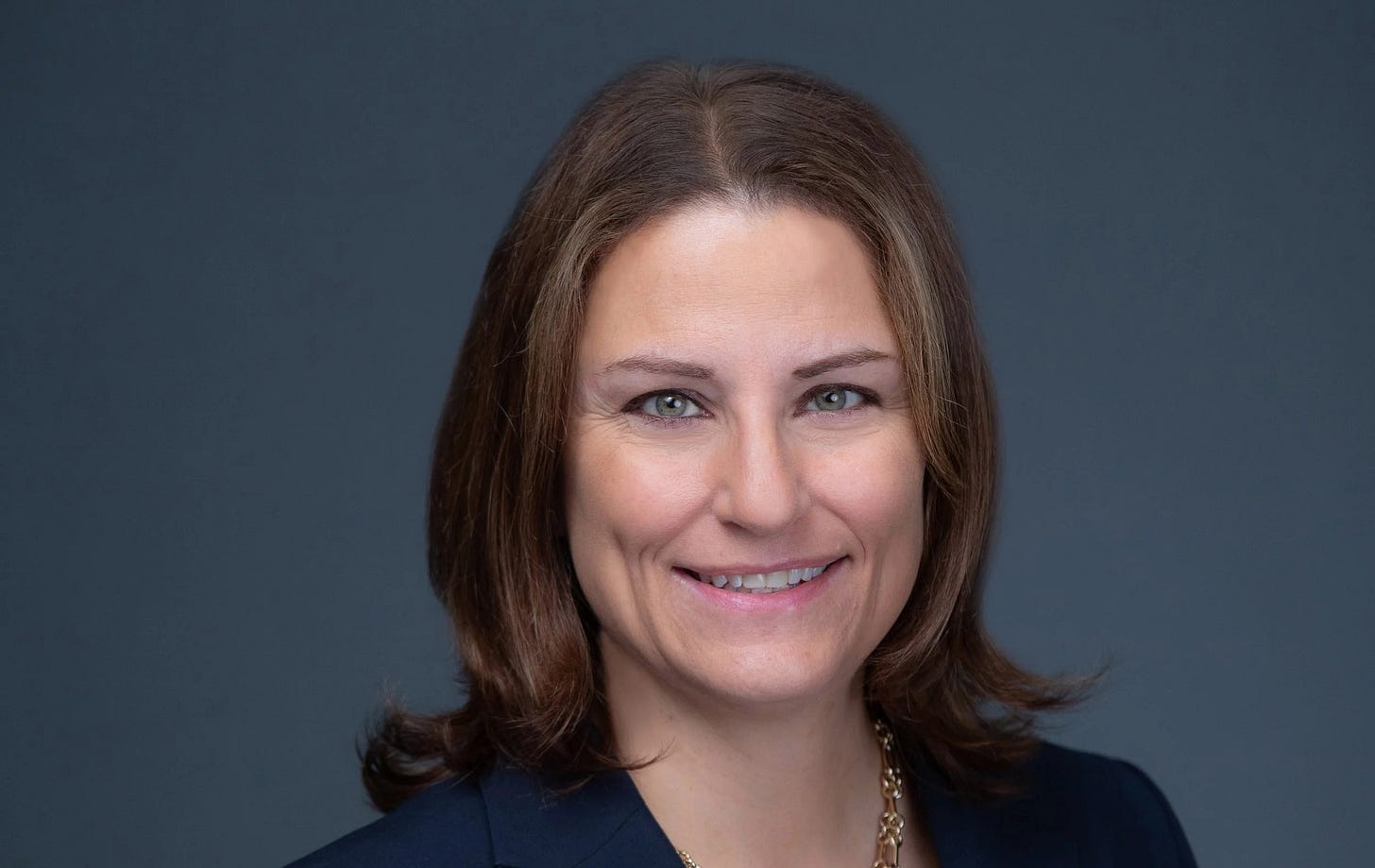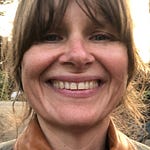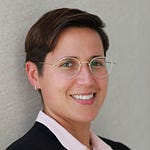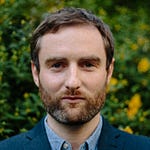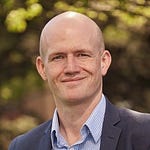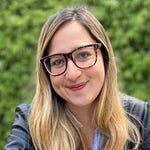New York passed one of the most ambitious climate laws in the country, but is now struggling to meet its goals. I’m joined by Doreen Harris, president of NYSERDA, the agency on the front lines of implementing the law. We explore what’s working, from community solar to new transmission lines, and what isn’t, including the slow pace of scaling up renewables and decarbonizing transportation.
(PDF transcript)
(Active transcript)
Text transcript:
David Roberts
Aloha. This is Volts for October 17, 2025, “How to get New York back on track toward its climate targets.” I’m your host, David Roberts. Back in 2019, New York State passed some of the most ambitious climate legislation in the nation, including a wide range of short- and long-term targets — for greenhouse gases, for clean cars, for utility-scale and distributed renewables, and more. Since then, as you might have noticed, a great deal has changed in US politics. And many of the tailwinds that made those targets seem achievable, like, say, the Inflation Reduction Act, have vanished.
And sure enough, New York is not meeting most of its targets. And sure enough, the state is being sued by activists for its failures.
The agency charged with navigating this dilemma is [clears throat] the New York State Energy Research and Development Authority, or NYSERDA, which is effectively in charge of state energy policy. How are the folks at NYSERDA thinking about the developments of recent years and how to get back on track?
To find out, at Climate Week NYC, I spoke with NYSERDA President Doreen Harris. We talked about what has changed to make things more difficult, what’s going on with the state’s suspended cap-and-invest program, where the state is succeeding, and how she envisions getting back on track for 2030.
Hello again. So just real quick, what the heck is NYSERDA? What does it stand for? Have you memorized this, presumably?
Doreen Harris
I’ve been wondering the same thing for 15 years, but I’m pretty sure I’ve got it figured out. I think Julian had it right. First of all, we’re a public benefit corporation. We are responsible for a few actions on behalf of the State of New York, but they broadly center around the energy transition — how to plan for the state’s energy needs, but also how to deploy programs and policies so as to achieve them. That’s our basic mission. Some might know it’s our 50th anniversary. Come on, come on. [applause]
So we came out of the energy crisis of the ‘70s really trying to bring solutions forward for New Yorkers. And that’s what we’ve been doing since then.
David Roberts
And to universal acclaim and appreciation?
Doreen Harris
I’d say it sort of depends on the day. I’ve had this job for five years. There’s been some high highs and low lows, but all in the direction that we’re supposed to be heading. So it’s good.
David Roberts
Well, let’s talk about this direction then. So New York famously passed, in 2019, very ambitious climate legislation with a bunch of discrete goals — not just a 2050 goal, but interim goals and goals for buildings and power. And it was a very big deal. New York is not meeting almost any of those targets, I believe. So I’ll just start with a very open-ended question. What are you trying to do to get back on track to meeting those targets?
Doreen Harris
I didn’t know this was going to be a budget hearing — this is like, this is tricky, tricky business.
David Roberts
It gets worse.
Doreen Harris
Oh great. It’s a fair question. So yes, as I said, I’ve been working in this role for five years. One of my primary responsibilities has been to set forth the actions that our Climate Action Council laid out. That was a multi-year process describing really what it would take to get to the goals of New York’s Climate Leadership and Community Protection Act. And believe me, even at that time when that plan was finalized, the plan itself reflects the fact that these goals are transformational, challenging, and certainly disruptive in some instances.
And that’s certainly how this has played out. We have actually a state energy planning process underway — that’s one of my other jobs, is to sort of make the energy plan forward for our state’s needs for the coming 15 years. And we have, through that plan, really looked at where we are, where we’re likely to head against many potential futures, among them a net zero future. We have had to have a bit of a reckoning over the last, particularly the last year, around the progress that we’ve had, which I would contend is notable. You may disagree, but I would contend is notable, and I think reflective of the progress that you can make when you are striving for goals like those within our climate law.
We’re balancing multiple objectives, that’s the heart of the matter, is that yes, we have specific statutory goals through our climate law, but we also have the need to balance a lot of other objectives, including reliability and affordability and, of course, the economic health of our state. So we’re taking a clear-eyed look at that as we speak and really reconciling the progress that is still ambitious but also achievable for our state.
David Roberts
Let’s take a couple of pieces of this. So one of the key mechanisms that was designed and envisioned to help you meet these climate targets, or greenhouse gas targets specifically, was the cap-and-invest program, which is supposed to cap... I’m just going to assume everybody here knows what a cap-and-invest program is. Please don’t, please don’t make me explain it. But that program has been halted, canceled, vague-ified? It’s not happening. It’s not clear whether it’s going to happen. What’s going on with it? Is it going to happen? And if it doesn’t, how are you going to make up the reductions that it was going to be responsible for?
Doreen Harris
Yeah, so one of the work streams through our Climate Action Council had been — there’s a whole chapter if you would like to read about economy-wide solutions. And that’s an example of an economy-wide solution would be a cap-and-invest program like our Clean Air Initiative that had been moving forward certainly in a variety of ways. And I think it is important to note that I fully agree with the perspective that when you are looking at a level of transformation that’s present within our Climate Act, but generally within the energy transition, that you have to embed the motivation, if you will, or the requirement for parties to change the way that they function.
And that is across all sectors of our economy. And I would further say that the ways in which we are funding this transition remain challenging because, of course, much of the costs are embedded in utility ratepayers, electric rates in particular, which is the very thing that you are wanting people to transition to.
David Roberts
We’ll come back to that.
Doreen Harris
Oh great. However, at the same time, we have needed to take, as I said, a very objective look at where we sit today and fundamentally what we can be doing in the climate in which we’re working. So I would not say that the Clean Air Initiative is — I forget your term, but I could imagine what it was. It is the case that we’ve had to go about this in a phased manner. We have the DEC advancing the reporting rule right now for comment and eventual adoption. We also have the governor making, in my view, something that has not been adequately supported or reflected — she literally just made the largest climate investment in the history of the state of New York through the Sustainable Future Program.
Just today, she announced the ways in which we intend to spend those funds. I would say that we’re being smart about how we move these processes forward so as to enable their ultimate success. And we, in the meantime, are investing in a manner that perhaps would have exceeded the funds that could have been raised by a program this year in any instance.
David Roberts
One follow-up: Are you actively working on the cap-and-invest program and do you anticipate it going into effect?
Doreen Harris
As I said, DEC is leading most of the work around this and I sort of actually...
David Roberts
I’m sorry, DEC?
Doreen Harris
Oh, the Department of Environmental Conservation.
First Audience Question
Thank you.
Doreen Harris
They’re the sister agency. I co-chaired the Climate Action Council with DEC, and ultimately NYSERDA will jump in when it comes time to design an auction and, of course, how ultimately to program the proceeds accordingly. It is moving, but I would contend that it’s moving in a rational, phased manner.
David Roberts
Got it. So another key plank of New York’s carbon reductions was going to come from off... Well, the idea was it was going to come from offshore wind. There’s a lot of projects underway, a lot of projects envisioned, a whole process underway — that’s been disrupted. Let’s just say Trump has canceled a bunch of them and has expressed clear hostility to future projects. How’s that going? Are you going to be able to move forward with offshore wind without federal support or with federal opposition, or where does that stand?
Doreen Harris
Yes, it’s a bit of a complicated soap opera, as it were, but I will try to just paint the big picture for you. You know, offshore wind really was, and it remains, a central aspect of how we get from here to there. When we looked at our 9-gigawatt goal, that is also in our Climate Act, it is the case that that could potentially serve as much as 25 to 30% of New York City’s electricity needs when we got to those outer years. So it’s a big deal, and it was a very major pillar of decarbonizing this very city that we’re all inhabiting, including during Climate Week, when I’m sure our load increases due to all the people here.
All that to say, there are a few parts of offshore wind that I’d like to reflect on. Number one, we actually have an operating offshore wind project — South Fork Wind Farm — entered operation. They just produced some extraordinary data coming out of that project for its first year of operation: over a 50% capacity factor, almost 90% availability during the summer peak. And ultimately, it’s delivering and it’s available. And that is very much what we as a state are committed to scaling up. And I know the governor has gone to bat multiple times over this. We have two projects that are under construction — the Empire Wind project and the Sunrise Wind project — both of which are on schedule and advancing toward a 2027 commercial operation date.
David Roberts
Are they vulnerable to him in some way? Like, could... Are they insulated in some way from his interference?
Doreen Harris
I wouldn’t presuppose what the federal government may be doing on offshore wind, but what I can say is we certainly got Empire Wind back on track very quickly, as I said, through the governor’s leadership. And ultimately, it’s reflective of how committed we are to this industry. Now, after these two projects are constructed, we have a real challenge on our hands. And as I said, we need to be reasonable about what we believe can actually be happening in the coming number of years. These are projects that take 10-plus years to be developed and constructed. So, what is happening today?
Our goal is to be in a position to have as small of a gap between these now three projects and the next project — that’s like our top priority. It does seem that we’ve reached perhaps the bottoming out of the challenges that we’re seeing. And really, as a state, I think what New York does in this industry will matter a lot. We have definitely not only continued to need to rely on this resource, but frankly, the way we are responding to these challenges, others are watching. So offshore wind has a long-term future in the state of New York. There is no doubt about it.
David Roberts
But like, could you fund it yourself without federal money? Is that possible?
Doreen Harris
So the biggest challenge with offshore wind we have right now is the permits in the sense that, theoretically, yes, if there were no tax credits for these projects, if we saw the value, we could fund them from a generation perspective. But if they can’t be sited and permitted, then we’re not in a position where there’s an actual project upon which to deliver. And that is like borderline heartbreaking for someone like me who has worked on this for so many years. However, we need to be rational about our planning. And when we look at the projects upon which we can avail ourselves, we still see actually a very significant buildout of renewable energy in the coming 15 years — on the order of 85% of what we have now.
So it’s a huge buildout of renewables that is part of our state energy plan. But we also have to serve load. And we have a network of very complicated urban environments here downstate. And the resources that we had planned to serve that load are, at a minimum, going to be delayed. So that’s the facts as of today.
David Roberts
Well, speaking of the other renewable buildout, you know, the New York climate activists will say that the buildout of utility-scale wind and solar is also behind targets. What are the primary challenges in the utility-scale game? Are those NIMBY, permitting, et cetera, et cetera, or is that a money problem that’s slowing that down? Or all of the above?
Doreen Harris
So look, we’re trying to do new things, right? We’re trying to scale up from a project a year to 20 projects a year. And with that comes growing pains. We did a lot as a state in the early 2000s so as to expedite the development and construction of renewable projects as a general matter — first, by centralizing the permitting and siting of these projects, but also by advancing faster interconnection processes to get from here to there. And the results have been marked. I mean, we have, again, as I speak, well over 100 projects in our pipeline. We have 20 under construction, and projects are moving at a far greater scale than that which I had ever experienced when I came to NYSERDA in 2010.
And in fact, I guess one hidden gem of the reconciliation bill is that those projects need to move ever faster in order to capitalize on tax credits for which they are only eligible for a limited period of time. So when we look at it, there will be a good use of those systems that we put into place to get those projects built. And the results, as we have seen them, are going to be significant in the sense that we will be bringing on many more projects into the future. Many of these companies have really needed to mature their own operations.
So I think that there has been sort of a maturation-of-industry challenge that we’ve seen. We see some consolidations.
David Roberts
Do you think the loss of tax credits might force a little bit of that discipline?
Doreen Harris
Totally, totally. I mean, I think it is the case that when we look at the technologies that we’re delivering, energy storage included within wind and solar, there is necessarily a maturation of these industries that’s necessary. And I do think the situation that we find ourselves in will aid in that progress.
David Roberts
Okay, another big plank of your carbon reductions was supposed to come from the transportation sector. And a big chunk of that was going to come from the fact that you were signed up to California’s Clean Car standards, which were quite ambitious, quite progressive. Trump killed that too — killed the Clean Car standards, killed California’s waiver. So how do you envision compensating in the transportation sector for the loss of that sort of federal tailwind?
Doreen Harris
Well, one thing that is important to note is right now we’ve made really good progress in the adoption of electric transportation of all sorts across the state. We have many billions of dollars of investment that have gone in, both by NYSERDA as well as the utilities. And we do see these markets shifting in a very notable way. Now, we are not at a California-level penetration by any means, but we find ourselves at a circumstance where, when we’re at, say, 10-plus percent EV sales, we see market transformation. That’s what we’re in the business of doing at NYSERDA — transforming markets.
We see that happening and we see it happening, of course, because there are incentives that can help reduce the first costs of these technologies from an adoption perspective. But we also see uptake, frankly, because people like them, and I think that’s an important part of this as well. As an EV driver myself, I wouldn’t — notwithstanding the tax credit — I think what we are experiencing is more people recognizing that change can be a good thing. But will these headwinds have impacts on adoption? Absolutely. And will we have a necessary adjustment in the market uptake? Definitely. But I think, as with anything else, we’ve got the preconditions for this market change to happen, albeit on a different pace.
David Roberts
And are there policies you could pass to accelerate? Are you talking about policies to accelerate the transportation, or are you just relying on the shift to EVs to happen organically?
Doreen Harris
I mean, we have any one of a number of incentives. We have a Drive Clean Rebate that we fund at NYSERDA to help, as I said, bring down the first costs of adoption. But make no mistake about it, we cannot, as a state, make up for the amount of detriment that has occurred to us in every sector of our economy. That is not something that we can sign New Yorkers up for. And so, we need to be clear-eyed about what is achievable versus what is sort of a more optimal circumstance.
David Roberts
Okay, one more dreary downer question. The Clean Path transmission project, another big piece of your emission reductions, was supposed to be piping in clean energy to congested areas via this Clean Path transmission project, which was going to bring around 5 gigawatts of clean energy into New York City. That’s now been canceled. What’s going to replace that?
Doreen Harris
Yeah, that’s a complicated one. No, I say this because transmission development in our state can happen via a variety of means. And we’ve demonstrated, in fact, I would say some of the best use of FERC Order 1000 in advancing bulk transmission projects of various sorts that are, in many cases, operating, in other cases under construction, across our state. So New York has made great use, actually, of these processes that we have used to build out major transmission infrastructure. We also have used the instrument that is NYSERDA to build out transmission. The sister project to the Clean Path Project is the Champlain Hudson Power Express project.
370-plus miles of transmission coming from Canada. Hydro-Québec is delivering hydro right here into the city. It’s going to serve about 20% of New York City’s electricity needs, and it is under construction. I saw it with my own eyes. I went on the vessel in the Hudson River and watched the cable be buried. The point being, like, we are advancing transmission of extraordinary means. The Clean Path Project is really a different circumstance in which they were looking for more of an expedited approach, not through our standard practices. So it’s not to say that project may not have a...
It could certainly have a future. It was just the decision of the Public Service Commission that the approach being taken was not required.
David Roberts
Got it. Okay. On a slightly happier question, one of the goals that New York is hitting is the distributed energy...
Doreen Harris
Thank you.
David Roberts
...goal.
Doreen Harris
I appreciate that.
David Roberts
We love distributed energy around here. Maybe you can tell us a little bit about just what that program is and why you think it’s been so successful?
Doreen Harris
The story of solar is one that I think is so interesting to look at from a historical perspective. So, would you give me a minute on this one?
David Roberts
Please.
Doreen Harris
Okay. So NYSERDA actually — again, I mentioned we’ve been around for 50 years. One of the very early areas we were investing in is actually solar because of the fact that we knew that the technology existed, but it needed to be matured, right? To be developed to the point where it could be commercialized. And so on my table in my office is a coffee table book from the 1970s from NYSERDA talking about how to install solar, passive house standards, et cetera, really demonstrating that these were indeed possible. And so when we saw that technology reach that level of maturation, that’s when we really went to our utility regulator and built out a program called New York Sun that allowed us to scale up distributed solar — not only because it was ready for the market, but frankly, it’s extraordinarily valuable in a state like ours in which we have various ways in which we need to serve load, among them community solar, which is a central part of how we got to that goal so early.
So we built that program up and we, as you said, exceeded expectations. The market met that CLCPA goal a year early. And now not only are we the number one community solar market in the nation for two years running — come on — but also we see the real benefits of the technology in action. So I mentioned what South Fork was delivering this summer. When we saw those summer peaks this summer, that 6-plus gigawatts of distributed solar reduced that peak by 5% and saved New Yorkers $90 million. So, yes, it is a big deal to our state.
It’s something we will continue to build on. And it’s reflective of really how we can take these early-stage technologies — of course, not alone, of course, there’s a solar market outside of our state — but these are the types of activities that we need to be advancing for the next version of solar, coffee-table book notwithstanding.
David Roberts
Well, pivoting back to downer, it looks like now New York is taking the remaining money from that very successful distributed energy program, which is paying off — and the one thing that is paying off — and taking it and using it for other things. Why are you not instead doubling down and increasing funding for the thing that’s working?
Doreen Harris
Yeah, I think this is another kind of misunderstood action, but I’ll try to describe it in as simple terms as possible. You know, we receive funding from the Public Service Commission to administer these programs. These are ratepayer funds. And we are always trying to match the amount of funding needed to get to the number that we’re supposed to get to. And as of now, the number we’re solving for is 10 gigawatts, and we’re well on our way. I would agree this market continues to build, although challenged, of course, by the federal context in this instance. All that to say, it’s a pretty simple decision by the Public Service Commission, which is to say that there are funds that were not needed to get to the 10 gigawatts.
We’re spreading a limited resource and those funds were to be used for other purposes. But I would agree generally that I’m really excited to be tackling the question, which is like, “What does a post-10-gigawatt distributed solar goal look like?” Like, this is where we really start to look at the value of distributed energy resources in a more expansive way.
David Roberts
Those targets are legislative, so it would have to be... The legislature would have to set a new, bigger target?
Doreen Harris
Goals can be in regulation or in legislation. So theoretically, if there were a larger goal, we wouldn’t necessarily need to have that in a legislative manner, but it certainly would be one that we would be looking at in the context of our state energy plan, which does reveal a need for more solar to be contributing on the order of tens of gigawatts of solar, in fact. So we have to work on the market mechanisms to realize those numbers. And that’s something that we’ll continue to do.
David Roberts
All right, let’s talk about electricity cost, because this is, I think, one of the sleeper issues of coming elections everywhere — coming presidential election. And it is unfortunate for a variety of reasons that the rise in electricity costs is happening at the same time that high-profile climate policy is being implemented. Because it’s a very, very easy story to tell the public that the one is causing the other. So I have a bunch of questions about that, but one is, and I ask this of California people all the time, a lot of these goals are public goods, public good goals that will be good for all the people of New York.
Has there been any talk about moving those costs off the rate base to the tax base? Because paying for things through ratepayers is the most regressive, conceivable way to pay for anything. Has there been any talk of moving any of these costs out and just paying for them with the more progressive state tax system?
Doreen Harris
What was California’s answer? I know you know — I’m just kidding.
David Roberts
I don’t remember. Which I think should tell you there were words, but I don’t remember.
Doreen Harris
I’m just curious. Always looking to learn from others.
David Roberts
They’re thinking about it. It’s an intriguing idea.
Doreen Harris
So it’s kind of harkening back to what I was saying before, that there are a lot of ways to pay for energy systems. And I agree electricity costs have become a very significant flashpoint that we’re all needing to reconcile. It is interesting that these costs are those that are very difficult also to plan around. You get your bill, you have to pay your bill. And it is the case that I think we need to be more consumer-centric generally with respect to utility bills. However, let me be clear about one very important thing — and in fact, our energy plan is really talking about this in some detail — which is the fact that we have infrastructure, in the case of New York, we have many, many, many decades-old infrastructure that needs to be invested in.
I mean, we have power generating stations that are 70-plus years old, we have pipes in certain service territories that are nearing a century old. We have investments that we need to be making irrespective of the energy transition. And, in fact, when we really layered the energy transition on top of normal costs, it’s like low single-digit percentages different. And, in fact, the Public Service Commission just issued a report revealing just this, that it is a relatively small amount, certainly today and even into our analysis well into the future. But it is the case that when you look at the ways in which we pay for this infrastructure, we do need to be looking at tax policy, we need to be looking at other sources of funding.
Of course, federal was a big, big benefit for the state of New York that we’re now really reckoning with. But even as I had mentioned, the investment that the governor announced earlier this year, it’s reflective of the fact that we recognize that an energy burden is a real thing that we need to reconcile.
David Roberts
Well, here’s a political question which you probably won’t want to answer, but I’m going to ask it anyway and give you so you can refuse to answer it. It is the fact that climate policy is not a huge percentage of cost, as you say. And I think people who understand the mechanisms of climate policy and the larger mechanism know that and know that there are clean energy and climate policies that can directly reduce bills. But it’s very easy for the public to think otherwise. And do you worry that when Governor Hochul backs off congestion pricing because it might be too costly, backs off cap-and-invest because it might be too costly, that she’s out there sending the signal climate policy is costly, “I’m hesitant to do it because I don’t want to impose a bunch of costs on you.” Do you worry that that’s communicating to New Yorkers and Americans generally, “Yes, climate policy raises your bills and ergo you should probably be hostile to it.” Are you worried about people getting that impression from what’s happening in New York?
Doreen Harris
Well, she didn’t back off on congestion pricing. Just saying —
David Roberts
She halved it.
Doreen Harris
Okay, but we have congestion pricing.
David Roberts
It rules, by the way, and it’s working amazingly.
Doreen Harris
But yes, we need to do a better job of explaining what it is we’re even talking about. I think that it is absolutely true that most people have no idea what their electricity bill is comprised of, why it exists the way it is. Volatility is like another very real issue that we’re dealing with. And I’m sure that most New Yorkers would not understand that that volatility is largely driven by the fossil fuels that we’re relying on that is driving our generation, the majority of our generation, and therefore our prices that we pay every month. We have an educational issue that we have to rectify.
I would agree, the politicization of costs and of energy as a general matter is something that is new for us. We’re not used to being the proverbial price of eggs. Right. We are reckoning with that in a way that the story will continue to play out. But one of the things that we produced in our draft state energy plan was an affordability study. And I think the other thing NYSERDA needs to do more of is explain more clearly how New Yorkers can actually lower their energy costs. Many, many New Yorkers — we looked at myriad sort of use cases across the state, from a rural upstate consumer to a low-income New York City consumer — and by all accounts, there’s operating costs to be saved if one converts from fossil fuels to an electric residence and, you know, transportation systems. But at the same time, we also recognize that there is an upfront cost in making that transition. And that is our other job, is to aid in realizing that transition on behalf of New Yorkers. And that’s going to require investments. But the topic of investment is one that needs to be better explained as well.
David Roberts
Speaking of money and investment, this came up in a California context too. And I would also like your take on it. One of the things all states are dealing with is this rush of data centers that want to hook up giant inflexible loads, which, you know, depending on how they’re hooked up and how they’re run, could either help the grid or hurt the grid. But one notable thing about the hyperscalers who want to build all these data centers is that they are very wealthy. They come bearing giant bags of money, and they’re in a hurry. Given the drying up of federal funds, you look around, who’s got bags of money? They do. Have you thought at all about trying to get investment out of them in exchange for hookup, in exchange for room on your grid?
Doreen Harris
I’ve totally thought about that. Well, again, when we look at our load growth as a state, this plan, our energy plan, is looking at approximately 20, 25% load growth over that planning horizon.
David Roberts
Over what time?
Doreen Harris
15 years. And we know that we already were planning for the load associated with transportation and building electrification, which is actually a very different load to plan for than these large loads that you’re referring to. And now our energy plan is really layered on the interconnection queue that exists primarily in upstate, but also here in the city around those large loads.
Now in New York, they take various forms. We have a major investment in the central New York area by Micron focusing on semiconductor manufacturing. And this is a huge, major... Well, it’ll be a multi-phase project, but it will ultimately be built out over the coming decade-plus. I would say economic development loads of all sorts are a really interesting opportunity to build generation to serve that load, both because of perhaps a willingness to pay. I’m not sure they all have that willingness to pay — just for clarity, it does seem to be somewhat dependent on the sector.
David Roberts
Well, put them in a vice and squeeze a little bit, let’s find out.
Doreen Harris
Well, but also it is the case that I think is a very useful way to sort of put the tools of the state behind that partnership that ultimately could lower cost, to your point, for consumers. Even if the entire project is not funded by a load, if there is a sort of partnership that can be forged, I think it is a very good thing to be considering. You know, NYSERDA is the primary buyer of new electricity generation in the state of New York. Like, actually, we’re the only buyers so much these days. So we have a really interesting opportunity to sort of pair our buying power with the buying power of others, but also with the technologies that can really be most useful to those types of loads.
And I don’t know if we’re ever going to talk about nuclear, but we probably will.
David Roberts
I was just about, literally just about to. So let’s do that. So Governor Hochul has said, you know, even as like offshore wind is getting smooshed and utility-scale wind and solar behind schedule, the governor has proposed building a giant nuclear plant. Now I’ll just say 100% of the evidence from the last several decades of experience suggests that that project will take way longer than anyone says it will take and will cost way more than anyone says it will take and will end up... You know, I don’t have to reprise the history of the nuclear industry.
The last example we have is in Georgia, which I don’t... I stopped tracking the cost overruns after a while. I don’t know what they ended up amounting to, but it’s a huge burden on Georgia ratepayers now. So why, why — like why, why? What reason do we have to think that a giant nuclear megaproject is going to be anything but what all the other nuclear megaprojects have been for the last several decades?
Doreen Harris
All righty. First of all, I think it’s important to note that we have not arrived at a technology solution that we are advancing with respect to her one-gigawatt directive to the New York Power Authority, it does not necessarily need to be an AP1000. It could be several smaller projects. It could be a lot of different things. That story has not been written yet with respect to how that...
David Roberts
So she means a gigawatt cumulatively, not necessarily like a gigawatt plant?
Doreen Harris
At least. So that’s point number one. Point number two is if we have learned anything over the last 10 to 20 years, and certainly if I have learned anything over the last 10 to 20 years, we need a diverse set of energy resources upon which to rely. Because if you had asked me five years ago if our offshore wind industry would be struggling in the way they are, I wouldn’t have said yes. Right?
So we need diversity and we need to keep multiple balls in the air in order to achieve a reliable, affordable clean grid of the future. So nuclear power in theory is one of those diverse resources. But are we taking a measured approach through a multi-year planning process and ultimately an order book? They talk about order books, right? Like we’re working with a number of other states to develop not only standardization with respect to technology — because there are many, many, many, many designs one could rely on — but also the longer-term vision to allow for the first of a kind to become something of a, as you said, a reduced cost for consumers.
But it is at the same time that there are other resources that we’re advancing too. The state energy plan takes a very clear-eyed look at the ways in which we believe we need to maintain our current fossil infrastructure, perhaps repower certain facilities while we continue that renewable buildout. But we need some of these emissions-free resources, nuclear being a great example of them, as options moving forward.
David Roberts
And geothermal too, just to tie the pods together.
Doreen Harris
That’s right.
David Roberts
Tie the pods together here today.
Doreen Harris
And of course, look, we saw what happened even under the Biden administration with respect to the ADVANCE Act, which really opened, as I said, kind of like solar. You have to take a look at where the market is. And when you see bipartisan federal support through the ADVANCE Act for these types of technologies, you have to say that the market will follow that lead and we want to be part of it. So it is not to say that we would ever believe New York could do this alone. We need to see where the market is. And I’ll tell you, I was just at a nuclear event earlier today and reflecting on what can happen in a year.
It’s really quite extraordinary. But we’re also clear-eyed about the challenges that exist, given our own history. I started my career in a nuclear power plant. I’m very familiar with the risks and the challenges. But I am here to say that technology evolution is one that we really want to be part of.
David Roberts
Interesting. Okay, one final question and maybe a question or two before we wrap up. There’s this lawsuit. So you have all these very ambitious goals, and then sort of like in the years since you passed them, there have been a number of adverse developments, as you say, at the federal level, particularly loss of offshore wind, the loss of just money, the loss of the transportation standards. The goal looks much more difficult now than it did then, but it is in statute. You have to do it, and it’s not getting done. And so there’s this lawsuit now. I know obviously you can’t sort of speak to the details of the lawsuit, but I’m just wondering how you’re navigating this kind of rock and a hard place between the statutes and the activists that are suing you to hit those goals and all these headwinds.
I don’t know what to say about that. But how do you feel about all that?
Doreen Harris
Well, I can’t comment on litigation. I can just say that I choose to look at this in a different way than you, clearly. I choose to look at it as we have demonstrated what it takes to be successful in advancing major infrastructure projects that require not only fortitude, but durable commitment and time. Now, we’ve also demonstrated the challenges of the energy transition, and I am also objectively knowing that this is not simple and it is occurring on a different timeframe, certainly than that which we would have anticipated at the time of the Climate Act signing. We have to just be okay with those differences, as far as I’m concerned.
I do not see this as anything other than the reality of major changes in the way society operates as opposed to an impossible outcome. And I agree we’ve got to start carrying that message. We’ve got a lot of successes that we can demonstrate as a state that we wouldn’t have had it not been for these goals, had it not been for the level of ambition that they established. I know we acted a lot, you know, in major ways we changed the way we worked at NYSERDA because of it. So I think it has value and I don’t want that to be lost on, you know, whether you hit a number or you don’t hit a number, it has more to do with the level of ambition that you’re solving for.
The State Energy Plan will be binding in the sense that state energy offices, agencies will need to consider it in their decision-making. And the Climate Act will be where it is — like, we are conducting bottoms-up planning to preserve and expand the benefits of the energy system for New Yorkers. And that’s my remit as the chair of the State Energy Planning Board.
David Roberts
All right, we have time for, I think, one or two questions.
First Audience Question
Hi, I’m Dave Velasquez, a climate-tech investor and also a New York City resident. So my question is, as a New York City resident and as somebody who lives in a co-op here in New York, a shareholder, I know Local Law 97 is something that has been... it’s basically the goal to decarbonize in the built environment here in New York City. And I’m curious how NYSERDA is helping to support that, you know, provide information and support those buildings that are trying to decarbonize.
Doreen Harris
Yes, great question. Looking around this beautiful city, it is, it’s one of the biggest challenges that we have is these buildings. And of course, Local Law 97 moving forward in the pace that it is. You know, we as a state, you know, this is a city versus a state ecosystem. But from a statewide perspective, we have a variety of pieces of work that are underway that, in the first instance, can fund some of these upgrades that are necessary through utility programs as well as NYSERDA. We have a new... We’ve been investing about $7 billion in energy efficiency and building electrification.
We now have a coming five-year tranche that will be invested against that as well. So that’s kind of point number one. Point number two, though, is on a statewide basis, we have been advancing different aspects of this building energy transition. We’ve actually started, coming January, with a zero-emission new construction requirement as a state that will apply, again, to low-rise buildings in the first instance and then a few years later, taller buildings. But one of the things that we know to be true — you and your co-op, not necessarily quite spot on — but like, you can construct these buildings in that manner far more easily than you can retrofit them.
So we’re actually super excited that we have the tools and resources to help support these buildings as we demonstrate the fact that they indeed are not only affordable, but people really like living in them. They’re quiet and clean and comfortable, but also these taller existing buildings — there’s a variety of market development initiatives that we have underway and Team NYSERDA can fill you in.
David Roberts
Is there work on the building code? On the state building code?
Doreen Harris
Absolutely. So this is through the code, the energy, and the building code.
Second Audience Question
Michael Downey with Energy Futures Initiative. We’re a clean energy think tank. One of the things that you hit on early in the conversation was some of the successes around distributed resources, community solar, et cetera. And then you’ve also talked about the need for a lot of these large loads to come on as quickly as possible, given that so much of the challenge that grid managers are facing today is about managing peak loads — so a few hours a year. Are you seeing any interest or starting to have conversations with some of these hyperscalers or other large loads about how to invest in deploying water heaters, other controllable loads at the residential/commercial level, to manage that peak load off-site?
Doreen Harris
Yeah, absolutely. There’s a number of proceedings at the New York Public Service Commission around this topic. I’m not the utility regulator, but it fundamentally is looking at just that. How can loads be more flexible, how can we use grid-enhancing technologies to get more out of the grid that we have, and ultimately how to use those loads in a more productive manner? Just like why you don’t want someone to charge their EV at peak, right? Like, it’s the macro version of that for a data center or others. Also, we have a very ambitious energy storage goal that we are now investing against, both from a retail, residential, and bulk perspective.
NYSERDA has a number of different programs that are heading toward a 6-gigawatt goal. Like, that’s going to be a big game changer, I think, in upstate New York in particular, from a bulk storage perspective, providing those same benefits, albeit not from the load perspective, but sort of complementary to the generation.
David Roberts
Are there VPPs in New York State? I think part of the question was about how to bring that spare household capacity to sort of apply to these macro problems.
Doreen Harris
Yes. So that’s what I was getting at with the Public Service Commission — we’re really making the consumer see value in those actions. Those are some of the rate designs that they’re looking at and technologies alike.
David Roberts
Got it.
Third Audience Question
Hi, Greg Remsen. I work at Luminary Labs, which is an innovation consultancy in New York City. Quick question about NYPA and if there’s anything exciting in the realm of public renewables that you could talk about or kind of like update us on?
David Roberts
Oh, right, I forgot to ask about that. You have this whole law, this whole program where you’re supposed to build public renewables. Who’s supposed to build them? Maybe give us a little 30-second background on that.
Doreen Harris
Well, it’s the alphabet soup of New York energy.
David Roberts
There are a lot of acronyms.
Doreen Harris
So the New York Power Authority is a sister authority to NYSERDA. They’re a public power utility who, via statute, now has formed and is executing against aspects of the Build Public Renewables Act, really focusing on using their own buying power, their own capacity, their capabilities as a public entity to further build out renewables. And so I don’t have their exact numbers underway, but it is the case that we have a bit of an interesting circumstance in which now NYPA is partnering with a variety of private sector developers with the intention to, I’d say, make more feasible the projects that they were already advancing and we would hope, as buyer at NYSERDA, more affordable. So that’s underway.
They report to their board quarterly. I always take a look at their pipeline of projects. They have a rather extensive pipeline of both large-scale distributed and now energy storage projects in addition to their nuclear objectives as well. So there’s a whole development aspect that NYPA is advancing through that statutory authority.
David Roberts
All right, we solved it.
Host
Thank you for, you know, putting up with David and standing up for New York State.
Doreen Harris
It’ll prepare me for January budget hearing. I’ll be ready. It’s all good. It’s all good. These are good questions to ask, right? It is not a simple situation that we find ourselves in. However, I really do want to say that, like, where I sit today, I want people to feel optimism that you live and work in a state like New York that is recognizing the challenges of the day, but also not backing down. So that’s where I am and happy to take the arrows. But ultimately, really good progress upon which to reflect. So, thanks for having me.
David Roberts
Thank you for being a good sport.
Thank you for listening to Volts. It takes a village to make this podcast work. Shout out, especially, to my super producer, Kyle McDonald, who makes me and my guests sound smart every week. And it is all supported entirely by listeners like you. So, if you value conversations like this, please consider joining our community of paid subscribers at volts.wtf. Or, leaving a nice review, or telling a friend about Volts. Or all three. Thanks so much, and I’ll see you next time.




